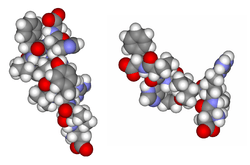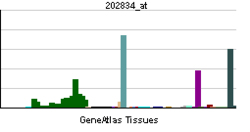Angiotensin
| View/Edit Human | |||
Angiotensin is a peptide hormone that causes vasoconstriction and a subsequent increase in blood pressure. It is part of the renin-angiotensin system, which is a major target for drugs that lower blood pressure. Angiotensin also stimulates the release of aldosterone, another hormone, from the adrenal cortex. Aldosterone promotes sodium retention in the distal nephron, in the kidney, which also drives blood pressure up.
Angiotensin is an oligopeptide and is a hormone and a powerful dipsogen. It is derived from the precursor molecule angiotensinogen, a serum globulin produced in the liver. It plays an important role in the renin-angiotensin system. Angiotensin was independently isolated in Indianapolis and Argentina in the late 1930s (as 'angiotonin' and 'hypertensin', respectively) and subsequently characterised and synthesized by groups at the Cleveland Clinic and Ciba laboratories in Basel, Switzerland.[2]
Precursor, and types of angiotensin
Angiotensinogen
Angiotensinogen is an α-2-globulin produced constitutively and released into the circulation mainly by the liver. It is a member of the serpin family, although it is not known to inhibit other enzymes, unlike most serpins. Plasma angiotensinogen levels are increased by plasma corticosteroid, estrogen, thyroid hormone, and angiotensin II levels.
Angiotensinogen is also known as renin substrate. Human angiotensinogen is 453 amino acids long, but other species have angiotensinogen of varying sizes. The first 12 amino acids are the most important for activity.
- Asp-Arg-Val-Tyr-Ile-His-Pro-Phe-His-Leu-Val-Ile-...
Angiotensin I
- Asp-Arg-Val-Tyr-Ile-His-Pro-Phe-His-Leu | Val-Ile-...
Angiotensin I (CAS# 11128-99-7) is formed by the action of renin on angiotensinogen. Renin cleaves the peptide bond between the leucine (Leu) and valine (Val) residues on angiotensinogen, creating the ten-amino acid peptide (des-Asp) angiotensin I. Renin is produced in the kidneys in response to renal sympathetic activity, decreased intrarenal blood pressure (<90mmHg systolic blood pressure[3] ) at the juxtaglomerular cells, or decreased delivery of Na+ and Cl- to the macula densa.[4] If less Na+ is sensed by the macula densa, renin release by juxtaglomerular cells is increased.
Angiotensin I appears to have no biological activity and exists solely as a precursor to angiotensin II.
Angiotensin II
- Asp-Arg-Val-Tyr-Ile-His-Pro-Phe | His-Leu
Angiotensin I is converted to angiotensin II (AII) through removal of two C-terminal residues by the enzyme angiotensin-converting enzyme (ACE), primarily through ACE within the lung (but also present in endothelial cells and kidney epithelial cells). ACE found in other tissues of the body has no physiological role (ACE has a high density in the lung, but activation here promotes no vasoconstriction, angiotensin II is below physiological levels of action). Angiotensin II acts as an endocrine, autocrine/paracrine, and intracrine hormone.
ACE is a target for inactivation by ACE inhibitor drugs, which decrease the rate of Angiotensin II production. Angiotensin II increases blood pressure by stimulating the Gq protein in vascular smooth muscle cells (which in turn activates an IP3-dependent mechanism leading to a rise in intracellular calcium levels and ultimately causing contraction). In addition, angiotensin II acts at the [[Na/H<sup>+</sup> exchanger]] in the proximal tubules of the kidney to stimulate Na reabsorption and H+ excretion which is coupled to bicarbonate reabsorption. This ultimately results in an increase in blood volume, pressure, and pH.[5] Hence, ACE inhibitors are major anti-hypertensive drugs.
Other cleavage products of ACE, seven or 9 amino acids long, are also known; they have differential affinity for angiotensin receptors, although their exact role is still unclear. The action of AII itself is targeted by angiotensin II receptor antagonists, which directly block angiotensin II AT1 receptors.
Angiotensin II is degraded to angiotensin III by angiotensinases located in red blood cells and the vascular beds of most tissues. It has a half-life in circulation of around 30 seconds, whereas, in tissue, it may be as long as 15–30 minutes.
Angiotensin III
- Asp | Arg-Val-Tyr-Ile-His-Pro-Phe
Angiotensin III has 40% of the pressor activity of angiotensin II, but 100% of the aldosterone-producing activity. Increases mean arterial pressure.
Angiotensin IV
- Arg | Val-Tyr-Ile-His-Pro-Phe
Angiotensin IV is a hexapeptide that, like angiotensin III, has some lesser activity.
Effects
- See also Renin-angiotensin system#Effects
Angiotensins II, III and IV have a number of effects throughout the body:
Adipic
Angiotensins "modulate fat mass expansion through upregulation of adipose tissue lipogenesis ... and downregulation of lipolysis " [6]
Cardiovascular
They are potent direct vasoconstrictors, constricting arteries and veins and increasing blood pressure. This effect is achieved through activation of the GPCR AT1, which signals through a Gq protein to activate Phospholipase C, and subsequently increase intracellular calcium.[7]
Angiotensin II has prothrombotic potential through adhesion and aggregation of platelets and stimulation of PAI-1 and PAI-2.[8][9]
When cardiac cell growth is stimulated, a local (autocrine-paracrine) renin-angiotensin system is activated in the cardiac myocyte, which stimulates cardiac cell growth through protein kinase C. The same system can be activated in smooth muscle cells in conditions of hypertension, atherosclerosis, or endothelial damage. Angiotensin II is the most important Gq stimulator of the heart during hypertrophy, compared to endothelin-1 and α1 adrenoreceptors.
Neural
Angiotensin II increases thirst sensation (dipsogen) through the subfornical organ of the brain, decreases the response of the baroreceptor reflex, and increases the desire for salt. It increases secretion of ADH in the posterior pituitary and secretion of ACTH in the anterior pituitary. It also potentiates the release of norepinephrine by direct action on postganglionic sympathetic fibers.
Adrenal
Angiotensin II acts on the adrenal cortex, causing it to release aldosterone, a hormone that causes the kidneys to retain sodium and lose potassium. Elevated plasma angiotensin II levels are responsible for the elevated aldosterone levels present during the luteal phase of the menstrual cycle.
Renal
Angiotensin II has a direct effect on the proximal tubules to increase Na+ reabsorption. It has a complex and variable effect on glomerular filtration and renal blood flow depending on the setting. Increases in systemic blood pressure will maintain renal perfusion pressure; however, constriction of the afferent and efferent glomerular arterioles will tend to restrict renal blood flow. The effect on the efferent arteriolar resistance is, however, markedly greater, in part due to its smaller basal diameter; this tends to increase glomerular capillary hydrostatic pressure and maintain glomerular filtration rate. A number of other mechanisms can affect renal blood flow and GFR. High concentrations of Angiotensin II can constrict the glomerular mesangium, reducing the area for glomerular filtration. Angiotensin II is a sensitizer to tubuloglomerular feedback, preventing an excessive rise in GFR. Angiotensin II causes the local release of prostaglandins, which, in turn, antagonize renal vasoconstriction. The net effect of these competing mechanisms on glomerular filtration will vary with the physiological and pharmacological environment.
| Target | Action | Mechanism[10] |
|---|---|---|
| renal artery & afferent arterioles |
vasoconstriction (weaker) | VDCCs → Ca2+ influx |
| efferent arteriole | vasoconstriction (stronger) | (probably) activate Angiotensin receptor 1 → Activation of Gq → ↑PLC activity → ↑IP3 and DAG → activation of IP3 receptor in SR → ↑intracellular Ca2+ |
| mesangial cells | contraction → ↓filtration area | |
| proximal tubule | increased Na+ reabsorption |
|
| tubuloglomerular feedback | increased sensitivity | increase in afferent arteriole responsiveness to signals from macula densa |
| medullary blood flow | reduction | |
See also
References
- ↑ "Human PubMed Reference:".
- ↑ Basso N, Terragno NA (Dec 2001). "History about the discovery of the renin-angiotensin system". Hypertension. 38 (6): 1246–9. doi:10.1161/hy1201.101214. PMID 11751697.
- ↑ "JAMA Article Jan 2012".
- ↑ Williams GH, Dluhy RG (2008). "Chapter 336: Disorders of the Adrenal Cortex". In Loscalzo J, Fauci AS, Braunwald E, Kasper DL, Hauser SL, Longo DL. Harrison's principles of internal medicine. McGraw-Hill Medical. ISBN 0-07-146633-9.
- ↑ Le, Tao (2012). First Aid for the Basic Sciences. Organ Systems. McGraw-Hill. p. 625.
- ↑ Yvan-Charvet L, Quignard-Boulangé A (Jan 2011). "Role of adipose tissue renin-angiotensin system in metabolic and inflammatory diseases associated with obesity". Kidney International. 79 (2): 162–8. doi:10.1038/ki.2010.391. PMID 20944545.
- ↑ Kanaide, Hideo; Ichiki, Toshihiro; Nishimura, Junji; Hirano, Katsuya (2003-11-28). "Cellular Mechanism of Vasoconstriction Induced by Angiotensin II It Remains To Be Determined". Circulation Research. 93 (11): 1015–1017. doi:10.1161/01.RES.0000105920.33926.60. ISSN 0009-7330. PMID 14645130.
- ↑ Skurk T, Lee YM, Hauner H (May 2001). "Angiotensin II and its metabolites stimulate PAI-1 protein release from human adipocytes in primary culture". Hypertension. 37 (5): 1336–40. doi:10.1161/01.HYP.37.5.1336. PMID 11358950.
- ↑ Gesualdo L, Ranieri E, Monno R, Rossiello MR, Colucci M, Semeraro N, Grandaliano G, Schena FP, Ursi M, Cerullo G (Aug 1999). "Angiotensin IV stimulates plasminogen activator inhibitor-1 expression in proximal tubular epithelial cells". Kidney International. 56 (2): 461–70. doi:10.1046/j.1523-1755.1999.00578.x. PMID 10432384.
- ↑ Boulpaep EL, Boron WF (2005). Medical Physiology: a Cellular and Molecular Approach. St. Louis, Mo: Elsevier Saunders. p. 771. ISBN 1-4160-2328-3.
Further reading
- de Gasparo M, Catt KJ, Inagami T, Wright JW, Unger T (Sep 2000). "International union of pharmacology. XXIII. The angiotensin II receptors". Pharmacological Reviews. 52 (3): 415–472. PMID 10977869.
- Brenner & Rector's The Kidney, 7th ed., Saunders, 2004.
- Mosby's Medical Dictionary, 3rd Ed., CV Mosby Company, 1990.
- Review of Medical Physiology, 20th Ed., William F. Ganong, McGraw-Hill, 2001.
- Clinical Physiology of Acid-Base and Electrolyte Disorders, 5th ed., Burton David Rose & Theodore W. Post McGraw-Hill, 2001
- Lees KR, MacFadyen RJ, Doig JK, Reid JL (Aug 1993). "Role of angiotensin in the extravascular system". Journal of Human Hypertension. 7 Suppl 2: S7–12. PMID 8230088.
- Weir MR, Dzau VJ (Dec 1999). "The renin-angiotensin-aldosterone system: a specific target for hypertension management". American Journal of Hypertension. 12 (12 Pt 3): 205S–213S. doi:10.1016/S0895-7061(99)00103-X. PMID 10619573.
- Berry C, Touyz R, Dominiczak AF, Webb RC, Johns DG (Dec 2001). "Angiotensin receptors: signaling, vascular pathophysiology, and interactions with ceramide". American Journal of Physiology. Heart and Circulatory Physiology. 281 (6): H2337–65. PMID 11709400.
- Sernia C (Jan 2001). "A critical appraisal of the intrinsic pancreatic angiotensin-generating system". JOP : Journal of the Pancreas. 2 (1): 50–5. PMID 11862023.
- Varagic J, Frohlich ED (Nov 2002). "Local cardiac renin-angiotensin system: hypertension and cardiac failure". Journal of Molecular and Cellular Cardiology. 34 (11): 1435–42. doi:10.1006/jmcc.2002.2075. PMID 12431442.
- Wolf G (2006). "Role of reactive oxygen species in angiotensin II-mediated renal growth, differentiation, and apoptosis". Antioxidants & Redox Signaling. 7 (9-10): 1337–45. doi:10.1089/ars.2005.7.1337. PMID 16115039.
- Cazaubon S, Deshayes F, Couraud PO, Nahmias C (Apr 2006). "[Endothelin-1, angiotensin II and cancer]". Médecine Sciences : M/S. 22 (4): 416–22. doi:10.1051/medsci/2006224416. PMID 16597412.
- Ariza AC, Bobadilla NA, Halhali A (2007). "[Endothelin 1 and angiotensin II in preeeclampsia]". Revista De Investigación Clínica; Organo Del Hospital De Enfermedades De La Nutrición. 59 (1): 48–56. PMID 17569300.
External links
| Wikimedia Commons has media related to Angiotensin. |
- The MEROPS online database for peptidases and their inhibitors: I04.953
- Angiotensins at the US National Library of Medicine Medical Subject Headings (MeSH)


